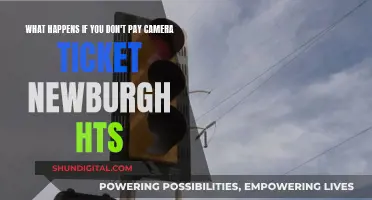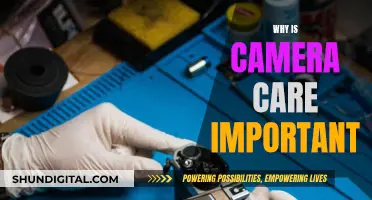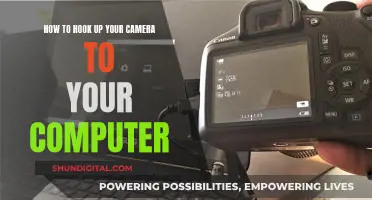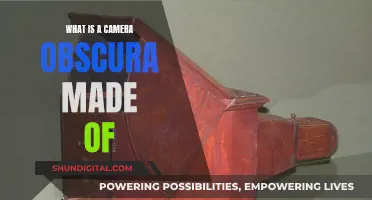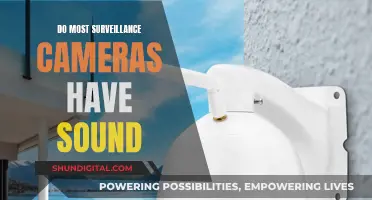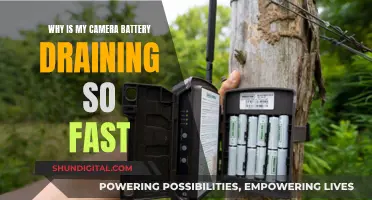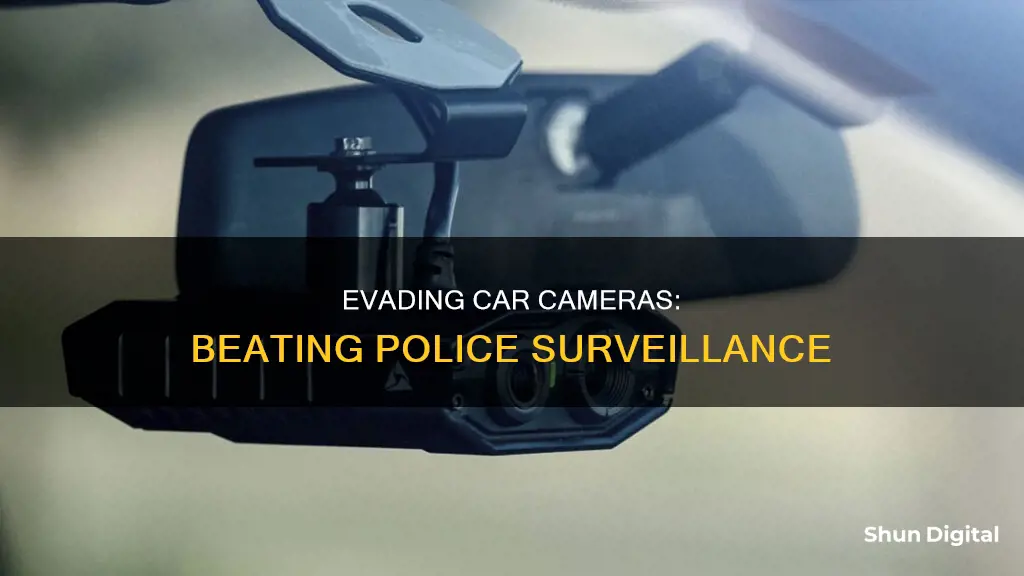
Police car-mounted cameras are used to capture video evidence to support investigations, prosecutions, and training efforts. They can also be used to monitor an officer's speed and to notify them if a car has a registration issue or an All-Points Bulletin (APB) attached to its tag number. While these cameras can be useful, there are ways to beat them. For example, radar detectors can be used to detect police radar and lidar, although radar detectors are illegal in some states and prohibited for commercial drivers. In addition, radar beams can be inaccurate if more than one car is speeding, as the beam can hit two vehicles in adjacent lanes. Other factors that can cause radar errors include wind, rain, and particles in the air.
What You'll Learn

Use a radar detector
Radar detectors are a great way to avoid getting caught by police car-mounted cameras. Radar detectors are little black boxes that contain a sensitive radio receiver that can pick up signals in the radar frequency range. They are usually adjustable, allowing you to detect faint, far-away police radar signals while screening out off-frequency signals from other sources.
Radar detectors are illegal in some states, and federal regulations prohibit commercial drivers from using them. However, if you are in a state where they are legal, a good radar detector can usually spot radar from miles away. These can be expensive, often $250 and up, but they can pay for themselves in a day.
When choosing a radar detector, look for one with GPS capability. This feature allows the device to lock out nuisance signals from automatic door openers. Without GPS, your detector will alert you every time you pass within half a mile of a Walmart. You should also look for a detector with good K-band filtering. Without this, you will be plagued by false alarms from Blind Spot Monitoring (BSM) systems on cars, which use the same K-band frequency as some police radar guns.
It is important to note that radar detectors are not 100% effective. Police officers may use instant-on radar, which is designed to defeat drivers with radar detectors. With this method, the radar is not transmitting until the officer spots a speeder and pushes a button. This means there is no signal for your detector to pick up until it is too late.
To avoid getting caught by instant-on radar, it is essential to be situationally aware. Know the types of speed enforcement technology used in your area and the places where police are likely to set up radar traps. Be on the lookout for patrol cars parked on the side of the highway, especially on freeway on-ramps. Also, remember that if you suddenly brake when you see an oncoming patrol car, the officer may assume you are using a radar detector.
In addition to using a radar detector, there are a few other ways to avoid getting caught by police car-mounted cameras. One is to use Google's Waze on your smartphone, which can alert you to the presence of speed traps. Another is to use a "rabbit," which involves following or pacing a vehicle that is speeding. However, this may annoy the driver you are pacing.
By using a combination of tools and strategies, such as a radar detector, Waze, and situational awareness, you can significantly increase your chances of avoiding a speeding ticket from a police car-mounted camera.
Speeding Tickets: When to Expect That Camera Ticket
You may want to see also

Drive with a radar detector
Radar detectors are an effective countermeasure to police radar guns. They are electronic devices that detect if your speed is being monitored by police using a radar gun. Radar detectors are generally used to help drivers reduce their speed before being ticketed for speeding.
Radar guns and detectors have been developed in tandem, with new frequencies, lengths of transmission, and signal strength being introduced to counter the other's technology. Radar detectors have also been developed to incorporate GPS technology, allowing users to manually store the locations where police frequently monitor traffic. These detectors can also be programmed to mute alerts when travelling below a certain speed.
When purchasing a radar detector, it is important to consider the range of detection, false alert filtering, GPS capabilities, and price. Here are some of the best radar detectors currently on the market:
- Escort Redline 360c: A top pick for long-range detection and ease of use. It offers arrows to help locate the source of threats, Bluetooth connectivity, and automatic updates. However, it is slower to detect quick signals and does not provide directional arrows for MultaRadar.
- Uniden R8: Offers outstanding performance, responsiveness, and range. It includes features such as photo radar detection, automatic and manual lockouts, and a multicolor OLED display. However, it has more false alerts than competitors and is not fully immune to radar detector detectors.
- Valentine 1 Gen2: A popular choice among radar detector enthusiasts due to its long-range performance, undetectability, and third-party app compatibility. It provides Bluetooth connectivity and automatic GPS lockouts but lacks dedicated frequency display and red-light/speed camera alerts.
- Uniden R7: The best bang for your buck, offering high performance at a relatively affordable price. It includes features such as automatic GPS lockouts, red-light/speed camera alerts, and photo radar detection. However, it is not fully immune to radar detector detectors and lacks Bluetooth connectivity.
- Uniden R4: The best non-arrow radar detector, offering excellent performance without directional arrows. It provides extreme sensitivity and responsiveness, automatic and manual GPS lockouts, and red-light/speed camera alerts. However, it struggles with Gatso detection and automatic lockouts.
- Uniden R3: The gold standard in its price range, offering high performance without breaking the bank. It includes GPS functionality, red-light/speed camera alerts, and photo radar detection. However, it does not offer arrows, auto lockouts, or Bluetooth connectivity.
It is important to note that the use of radar detectors is illegal in some countries and may result in fines or confiscation of the device. Be sure to check the local laws and regulations before using a radar detector.
Charging Pentax Cameras: A Quick Guide to Powering Your Device
You may want to see also

Use Google's Waze on your smartphone
Google's Waze is a navigation app for phones that helps road users avoid congestion by providing alternate routes. It also allows users to log accidents, road works, police stops, and speed camera locations, among other potential road stops, by tapping on the screen. While the app is legal, Western Australia Police Minister Michelle Roberts has stated that users could be breaking the law if they enter any information while driving.
Waze alerts drivers to the presence of speed cameras and hazards, and users can manage their alerts on their phones. If you're driving over the speed limit, you’ll get both an alert on the map and a voice alert. If you're driving at or under the speed limit, you’ll only get an alert on the map. Speed cameras are added to the map based on reports from Waze's partners and map editors, so if a speed camera wasn't reported by an editor or partner, Waze may not know about it.
Waze users can also alert other drivers of police stops and speed camera traps by tagging them on the app. However, police are becoming aware of this and have started to untag themselves so that they can catch more people speeding. Despite this, Waze users can still help each other avoid police and speed cameras by actively tagging and reporting their presence.
Game Camera Battery Life: How Long Do They Last?
You may want to see also

Use a rabbit
One of the primary ways to beat police car-mounted cameras is to use a "rabbit." This strategy involves following or pacing another vehicle that is speeding, ideally at a sufficient distance to avoid annoying the driver. By doing so, you can take advantage of the limitations of police radar technology and potentially avoid getting a speeding ticket.
When using a "rabbit" strategy, it's important to maintain a safe distance from the vehicle you are following. This is because police radar beams tend to spread out as they travel farther, increasing the likelihood of capturing the speed of multiple vehicles in the vicinity. By keeping a reasonable distance, you reduce the chances of your speed being accurately captured by the radar beam.
It's worth noting that pacing or following another vehicle is just one technique to consider. Other methods to avoid police car-mounted cameras include being situationally aware, using a radar detector, utilizing smartphone applications like Google's Waze, and familiarizing yourself with the stationary positions commonly used by police in your area.
Additionally, understanding the different types of speed enforcement technology used in your region can help you anticipate and potentially avoid being caught by police car-mounted cameras. Remember to always follow local speed limits and drive safely.
Traffic Monitoring: Camera Tickets for Vehicles?
You may want to see also

Familiarise yourself with stationery positions
Familiarising yourself with the stationary positions of police car-mounted cameras can be an effective strategy to avoid detection. These cameras are often positioned in fixed locations, and knowing their locations can help you take alternative routes or employ countermeasures to avoid being captured on camera.
Firstly, it is important to understand the purpose of these stationary cameras. They are typically part of an automatic license plate reader (ALPR) system, which is used to capture the license plates of vehicles nearby. These scanners have a wide range and can snap pictures of parked cars, as well as moving traffic. The system then checks these license plates against various databases to identify vehicles of interest.
To beat these cameras, you need to know the common locations they are found in. These can include toll booths, intersections, and town borders. For example, some towns have ALPR units at their entry points to track vehicles entering the area. By being aware of these locations, you can plan your routes to avoid these cameras or take measures to obscure your license plate when passing through these areas.
Additionally, stationary police car-mounted cameras are often positioned to cover a wide area. They may be installed on police cars that are parked or stationed in specific locations, such as busy highways or streets with high crime rates. These cameras can capture footage of the surrounding area, including parked and moving vehicles. Knowing the usual spots where police cars mount these cameras can help you anticipate and avoid these areas.
It is also worth noting that stationary cameras may have blind spots or limitations in their coverage. For instance, there may be angles or areas that are not within the camera's field of view. Understanding these limitations can provide you with opportunities to manoeuvre out of the camera's line of sight or use techniques to block their view temporarily.
In conclusion, familiarising yourself with the stationary positions of police car-mounted cameras involves knowing the common locations of ALPR units, understanding the coverage and limitations of stationary cameras, and using this knowledge to plan alternative routes or employ countermeasures to avoid detection. Remember to stay informed about any changes in camera locations and adapt your strategies accordingly.
Understanding Program Mode: Camera's Auto-Adjusting Setting
You may want to see also
Frequently asked questions
Police car-mounted cameras are often used for automatic license plate recognition (ALPR). These cameras can scan and research up to 1,800 plates a minute, even on cars racing by at 150 mph. The best way to avoid being caught by these cameras is to avoid driving if you think you may be flagged by them, for example, if you have a suspended license or your car registration has expired.
Police car-mounted cameras are used for automatic license plate recognition (ALPR). They can be used to enforce laws, such as pulling over cars with registration issues or All-points Bulletins (APBs).
Police car-mounted cameras work by snapping pictures of license plates and running them through local, state, and federal databases. If a plate of interest is found, the system warns the police officer with an audible warning and a notification on their computer.
The benefits of police car-mounted cameras include increased community trust, improved officer training, and better investigations and prosecutions. They can also help to enhance officer safety and promote transparency within law enforcement agencies.


